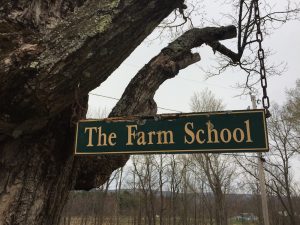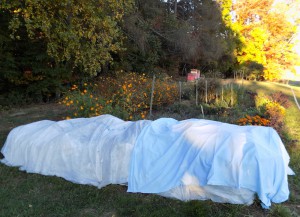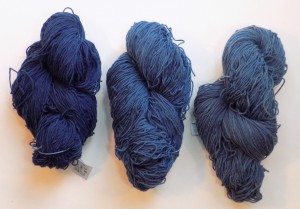One of the fun things I got to do last week was to visit the Farm School in Athol, MA, and to lead a natural dyeing workshop for the participants in their adult farming program. The Farm School combines two of my favorite things: agriculture and education. I had never visited their farm before, so I was thrilled to have the opportunity to be there and to get a better understanding of their different programs. I was greeted by this cheery sign when I first arrived:
Gleeful Woad Vat
On July 18th and 19th I ran a woad vat! This is exciting because last summer I planted woad, but didn’t have time to use it for dyeing. That made me sad, and I vowed to rectify that this summer. This summer I planted two beds about a month apart, so that the leaves will mature at different times. I ran this first vat of the summer with much glee and happiness.
I stuck with my tried and true but not truly “sustainable” chemical vat, using ammonia and RIT Color Remover. One of these years I will learn how to precipitate my own woad powder and master a natural fermentation vat (maybe even the urine vat!). Meanwhile I dyed some fiber blue with my own woad and it made me happy. Continue reading “Gleeful Woad Vat”
Exciting Lichen Information!
After all the flax-related posts lately, you might be justified in thinking that I don’t care about dye plants anymore. Not true! I thought I’d kick off what I hope will be a series of posts about dye plants with a link to a fascinating article about recent research on lichen.
OK, technically a lichen isn’t a plant. What exactly is it? Well, I used to think that a lichen was a symbiotic organism composed of a fungus and an algae (perhaps more accurately, “alga” singular). My go-to definition is from Lichens of North America by Irwin M. Brodo, Sylvia Duran Sharnoff, and Stephen Sharnoff. This massive and beautiful book is one of my prized possessions, acquired from Raven Used Books in Northampton many years ago (FYI my beloved Matthew is a former employee and does their website, as well as websites for many other good folk). (12/30/2023 Edited: I updated the link to Lichens of North America. Also, Matthew is no longer a professional web worker.)
I abbreviate the definition here:
“[A] lichen is not a single entity, but a composite of a fungus and an organism capable of producing food by photosynthesis. Lichen fungi can associate with green algae or cyanobacteria (the latter also known as blue-green algae), or sometimes both […]. The special biological relationship found in lichens is called symbiosis.”
The authors also offer a sweet, almost diminutive term for the photosynthetic symbiont, “photobiont, for short,” which is a word I aspire to slip into casual conversation more often. (Well, OK, ever!)
However, please follow this link for some exciting new insights into the life of lichen ….
Winnowing and Wine Bottles
OK, so I said earlier that I am bad at winnowing. This is still mostly true. I also said that on the next sunny weekend day I would use the wine bottle method to get the seeds off my flax in an efficient way. This is only a bit true, but it’s “truthy” in a way that can be explained with details and isn’t a lie.
This post is about how I spent a significant portion of April vacation removing the seeds from six varieties of flax from last summer, and got it cleaned up for planting. I know that ostensibly my blog is about dyeing, but I have been flax-obsessed lately. You might have noticed the flaxy-flaxy-flax-flax theme…. So, yeah. Flax. Again. Continue reading “Winnowing and Wine Bottles”
Low Humidity! April Vacation!
It is a truth universally acknowledged that if you want to process flax, you’d better do it while the humidity is low. I am not entirely positive why this is so, but I know from experience that it is true. If you try to break or scutch your flax while it’s humid, the stalks just bend and the shives cling to the fibers for dear life. You do not hear the gratifying crackling, snapping sounds that should accompany such activities. It is arduous and futile. Well, maybe not futile, but it’s certainly a lot easier and more successful when the humidity is low.
I suspect that this is related to one of the properties of linen that make it a desirable fabric. Flax fibers are hydrophilic, meaning that they absorb water easily. I am sure someone has done research on how being damp also makes flax want to stick to itself. If you know of good resources on this, shoot me an email.
For the past several days here in western Massachusetts, we have had very, very low humidity. Well, low for Massachusetts. It’s been anywhere from 30-50% in the morning, dropping to about 18% in the afternoon. The weather has also been bright, sunny and warm. And best of all, it is April vacation! So, I have had time to sit and process flax! Everything I’m working on this week is the variety Marilyn, though I’m chipping away at bundles from various years. Continue reading “Low Humidity! April Vacation!”
Magnification Technology Mach 2
Apparently one of the unforeseen functions of my blog is to document the decline in my vision over the decade of my forties. I have written about it here and here. Despite my attempts to be philosophical about it, I still find it annoying (at best) and unsettling (at worst) that I can’t see as well as I used to. Fortunately, magnification technologies come to my rescue at opportune moments. So honestly I cannot complain. Here’s a great example of such a rescue.
I’ve been stripping the seed bolls off of my flax from last summer, and sifting through debris for individual seeds. Flax seeds are shiny and glossy, and they stand out amidst the beautiful but comparatively lusterless dried leaves, flowers, and other bits of plant debris. Well, they stand out a *bit*. They do not stand out a *lot*. The chaff and other debris are highly textured and multicolored, and even glossy, shiny seeds can get lost in the mix. Especially with my not-so-awesome eyesight. The other day I was stripping the seeds off of the variety called Ariane. I’d removed all the seed bolls from the plants. Yay. However, I had a huge pile of debris to sift through with loose seeds mixed in. Sigh. Time to double down. Continue reading “Magnification Technology Mach 2”
If It’s April It Must Be Time to Plant Flax
It is, in fact, April. No foolin’. I am excited that it’s spring but, as usual, I’m ill prepared. Even though we had a mild winter here in terms of temperatures and snowfall, it was still winter. And I was still surprised by the sudden acceleration of the hours of daylight around the spring equinox. Winter winter winter winter winter, then, ta da, spring!
The other day I read on a blog post from one of the Vävstuga students that they had planted flax as part of the Väv Immersion class. Tip: hit the back button to get back to my post from these links. (12/30/2023 Edited: Updated Väv Immersion link.)
What? I felt a sudden panic. I am not ready to plant. Continue reading “If It’s April It Must Be Time to Plant Flax”
FIBERuary in Western Massachusetts
In case you haven’t heard, it’s FIBERuary here in Western Massachusetts! Carole Adams, of Whispering Pines Fiber and Herb Farm in Colrain, came up with the idea as a way to promote local fiber farmers. She was inspired by an initiative in the UK called Wovember which encouraged people to think more deeply about where wool comes from, to celebrate the incredible diversity of British wool, to wear 100% woolen garments, and to knit with British wool. (12/30/2023 Edited: It is with great sadness that I must share that Carole Adams died in 2022. She was my first spinning teacher in 1999, and a continual inspiration in my fiber world.) Continue reading “FIBERuary in Western Massachusetts”
Japanese Indigo and Frost
We’ve had a pretty mild winter thus far around here. Today, though, I have a snow day so I’m catching up on a post I started writing ages ago. This post is about nursing my Japanese indigo plants through the frosts in the fall. When the first frost was forecast on October 10, 2015, I bundled up the plants nice and snug.
Wrapping Up A Loose End
I have not done much dyeing lately. My last dye day was on September 6th when I ran my second Japanese indigo vat. Since then, I managed to rinse and dry the skeins, but didn’t get much further than that. They’ve been sitting in a tub waiting for closure. On New Year’s Eve I finally wrapped up that loose end.
As I noted in my original post, I don’t have good photo-documentation about that vat. But at least now I can show you photos of the skeins I dyed. All the yarns are wool. Here are the blue skeins.



